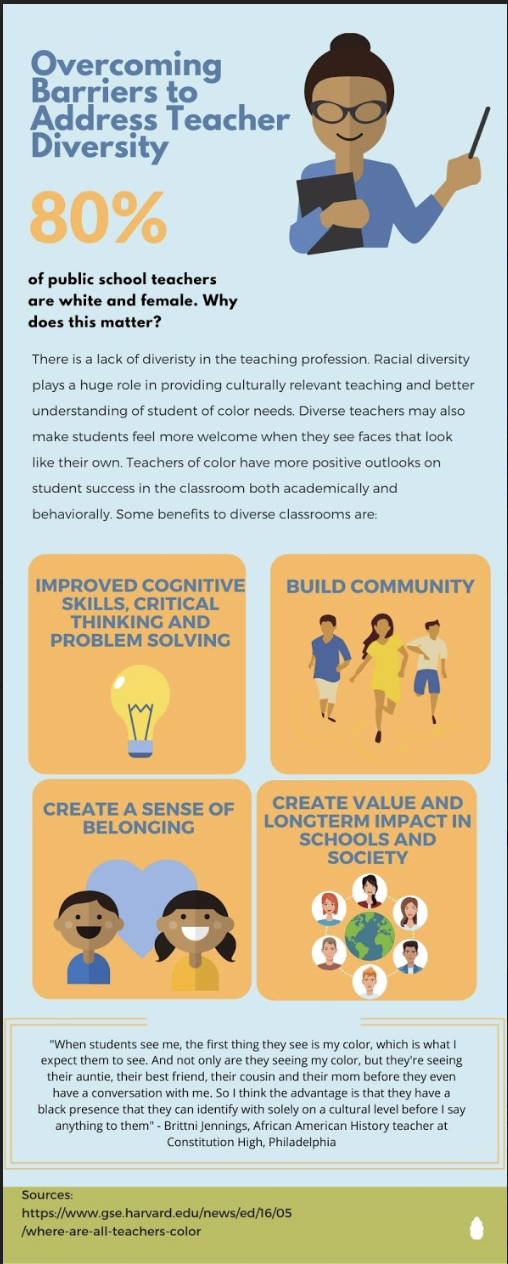“When I was an undergraduate, and I went to apply for student teaching, my counselor said, you’re going to definitely get a job because you’re a double minority. you’re black, and you’re a woman. And we need both of those in the district.”

Brittni Jennings is an African American history teacher at Constitution high school in Philadelphia. She is one of the two staff members at her school who are black on an administrative level. While teaching African American history, she feels it is important to teach students to see through the lens of a particularly white America to become socially conscious and pursue any career they see fit.
80 percent of teachers in America are white and female. This makes the United States education system very divided between students and their teachers. The United States has schools that show a very diverse student body. Teacher diversity can make a difference in the educational experience.
Studies show that having teachers of different racial backgrounds can positively affect a student’s performance in school and not just only for students of color. White students show improved problem solving, critical thinking and creativity. Likewise, that students of color who at least have one teacher with a different background than their own may perform better on tests and have less disciplinary issues.
When there are disciplinary issues involved in students, there is also implicit bias involved in teachers and this is something that they might not even be aware of having.
“You see that more when you get to inner city schools like Philadelphia. There are a lot of stereotypes associated with urban environments. I think teachers go in thinking that they are going to save all these black and brown kids without understanding the demographic they’re teaching in so when they get there, and they’re just coming in with that savior syndrome, that distracts them from what they need to be doing,” said Jennings.
“I think a part of that comes from implicit bias. We have a lot of teachers that are from the same communities as these kids and are not from the same communities as these kids. But there is a there is a racial lens in which they see the kids, even if they don’t acknowledge it or they don’t even understand it. They’re doing it.”
According to The National Education Association, implicit bias refers to the unconscious attitude or stereotypes that affect our actions, beliefs, and memories. Teachers do not understand the behaviors of a child beyond school and there might be something that plays a role in their behaviors, which can come from something in their personal lives.
The role of implicit bias goes beyond the teachers and can affect areas like standardized testing, school dress code, curriculum and eventually the achievement gap.
Jennings realized this when she took standardized exams as an undergraduate student.
“I noticed that a lot of questions they were asking me had nothing to do with my culture or things that have come out of my culture pertaining to the subject. I remember they were probably three or four Are these African American history on the social studies exam, there were probably five black authors mentioned on the English standardized testing for educators exam. And I think that’s mirrored on an elementary level, middle school and high school level. And I feel like when you give kids a test full of implicit bias, you’re also sending a message to them, covertly, that their identities don’t matter.”
Schools also make dress codes about students’ socioeconomic class. According to adl.org, wealthier schools show their privilege and lower income schools have uniforms for serious learning environment purposes.
Aspects of schooling like standardized testing, school dress codes and curriculum are other things that can negatively affect a student’s experience outside of having a teacher who misunderstands them. Implicit bias starts with teachers. It is important for teachers in society to completely understand the role they have in children’s lives and it is important for schools to understand how to make their teaching staff more diverse for better results in all areas academically.
Jennings knows that schools need more diverse teachers now more than ever.
“Schools need teachers, that’s really that’s really all I have to say like schools need teachers. Particularly black teachers, if I’m not mistaken, only 7% of our country’s teachers are African American and out of that 7% 2% are black males… And I’m not saying that to disvalue teachers who are not black, but I am saying when students of color walk into a building and the only people that they see representing them are the janitors and the cafeteria staff, it sends a covert an I think, an overt message, that they’re not good enough. I think we just need to do a better job of creating more diverse teaching environments or education environments.”
For more information on understanding implicit bias and removing barriers to address teacher diversity visit EduEquityforAll.com


